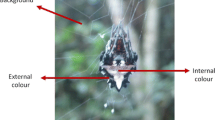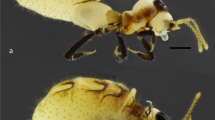Abstract
Irrespective of the selective advantage deriving from similar color pattern, the evolution of Batesian (and Müllerian) mimicry between distantly related insects groups has been perhaps facilitated by the availability to both models and mimics of similar pattern units more likely to be expressed, and to be modified in parallel ways, due to shared developmental constraints. We explore this hypothesis in a comparison of units of black-and-yellow color patterns between wasps (Vespidae) and those syrphids (Syrphidae) that are considered to be their Batesian mimics. As a proxy for evolvability we analyzed the co-occurrence of multiple color pattern within species (either as serial homologues or as expression of intraspecific variation) in 203 species of syrphids and 127 species of wasps. In both the wasps and the syrphids, the most frequent black-and-yellow patterns on the abdomen—all shared between the two insect groups—are also the most extensively linked in the networks of intraspecific co-occurrence, but are not the same in the two insect groups: in accordance with our hypothesis, this suggests positively biased evolvability.





Similar content being viewed by others
References
Arias, M., le Poul, Y., Chouteau, M., Boisseau, R., Rosser, N., Théry, M., et al. (2016). Crossing fitness valleys: Empirical estimation of a fitness landscape associated with polymorphic mimicry. Proceedings of the Royal Society B, 283, 20160391.
Bates, H. W. (1862). Contributions to an insect fauna of the Amazon valley (Lepidoptera: Heliconidae). Transactions of the Linnean Society of London, 23, 495–556.
Beldade, P., Saenko, S. V., Pul, N., & Long, A. D. A. (2009). Gene-based linkage map for Bicyclus anynana butterflies allows for a comprehensive analysis of synteny with the lepidopteran reference genome. PLoS Genetics, 5, e1000366.
Brown, E. S. (1951). Mimicry as illustrated by the British fauna. New Biologist, 10, 72–94.
Csardi, G., & Nepusz, T. (2006). The iGraph software package for complex network research. InterJournal, Complex Systems, 1695. http://igraph.org.
Dittrich, W., Gilbert, F., Green, P., McGregor, P., & Grewcock, D. (1993). Imperfect mimicry: A pigeon’s perspective. Proceedings of the Royal Society of London B, 251, 195–200.
Edmunds, M. (2000). Why are there good and poor mimics? Biological Journal of the Linnean Society, 70, 459–466.
Fusco, G. (2008). Morphological nomenclature between patterns and processes: Segments and segmentation as a paradigmatic case. Zootaxa, 1950, 96–102.
Gilbert, F. (2005). The evolution of imperfect mimicry. In M. D. E. Fellowes, G. J. Holloway, & J. Rohlff (Eds.), Insect evolutionary ecology (pp. 231–288). Wallingford: CABI.
Gotelli, N. J., Hart, E. M., & Ellison, A. M. (2014). EcoSimR. Version. 0.1.0. Null model analysis for ecological data (R package). https://cran.r-project.org/package=EcoSimR.
Goulet, H., & Huber, J. T. (1993). Hymenoptera of the world, an identification guide to families. Ottawa: Centre for Land & Biological Resources.
Grimaldi, D., & Engel, M. S. (2005). Evolution of the insects. New York: Cambridge University Press.
Haarto, A., & Kerppola, S. (2007). Finnish hoverflies and some species in adjacent countries. Keuruu: Otavan Kirjapaino Oy.
Hendrikse, J. L., Parsons, T. E., & Hallgrímsson, B. (2007). Evolvability as the proper focus of evolutionary developmental biology. Evolution and Development, 9, 93–401.
Howse, P. E., & Allen, J. A. (1994). Satyric mimicry: The evolution of apparent imperfection. Proceedings of the Royal Society of London B, 257, 111–114.
Ito, K., Katsuma, S., Kuwazaki, S., Jouraku, A., Fujimoto, T., Sahara, K., et al. (2016). Mapping and recombination analysis of two moth colour mutations, Black moth and Wild wing spot, in the silkworm Bombyx mori. Heredity, 116, 52–59.
Karlsson, D., & Ronquist, F. (2012). Skeletal morphology of Opius dissitus and Biosteres carbonarius (Hymenoptera: Braconidae), with a discussion of terminology. PLoS ONE, 7(4), e32573.
Kauffman, S. A. (1983). Developmental constraints: Internal factors in evolution. In B. C. Goodwin, N. Holder, & C. C. Wylie (Eds.), Development and evolution (pp. 195–225). Cambridge: Cambridge University Press.
Kikuchi, D. W., & Pfennig, D. W. (2012). A Batesian mimic and its model share color production mechanisms. Current Zoology, 58, 658–667.
Kikuchi, D. W., & Pfennig, D. W. (2013). Imperfect mimicry and the limits of natural selection. Quarterly Review of Biology, 88, 297–315.
Kikuchi, D. W., Seymoure, B. M., & Pfennig, D. W. (2014). Mimicry’s palette: Widespread use of conserved pigments in the aposematic signals of snakes. Evolution and Development, 16, 61–67.
Kleinberg, J. M. (1998). Authoritative sources in a hyperlinked environment. In Proceeding SODA’98 proceedings of the 9th annual ACM-SIAM symposium on discrete algorithms (pp. 668–677). San Francisco.
Martin, A., Papa, R., Nadeau, N. J., Hill, R. I., Counterman, B. A., Halder, G., et al. (2012). Diversification of complex butterfly wing patterns by repeated regulatory evolution of a Wnt ligand. Proceedings of the National Academy of Sciences of the United States of America, 109, 12632–12637.
McAlpine, J. F. (1981). Morphology and terminology—Adults. In J. F. McAlpine, B. V. Peterson, G. E. Shewell, H. J. Teskey, J. R. Vockeroth, & D. M. Wood (Eds.), Manual of nearctic diptera. Vol. 1 (pp. 9–63). Research Branch, Agriculture Canada, Monographs 27.
Müller, F. (1879). Ituna and Thyridia: A remarkable case of mimicry in butterflies. Proceedings of the Entomological Society of London, 1879, 20–29.
Nadeau, N. J., Pardo-Diaz, C., Whibley, A., Supple, M. A., Saenko, S. V., Wallbank, R. W. R., et al. (2016). The gene cortex controls mimicry and crypsis in butterflies and moths. Nature, 534, 106–110.
Pape, T., Blagoderov, V., & Mostovski, M. B. (2011). Order Diptera Linnaeus 1758. In Z.-Q. Zhang Z-Q, (Ed.), Animal biodiversity: An outline of higher-level classification and survey of taxonomic richness. Zootaxa, 3148 (pp. 222–229).
Penney, H. D., Hassall, C., Skevington, J. H., Abbott, K. R., & Sherratt, T. N. (2012). A comparative analysis of the evolution of imperfect mimicry. Nature, 483, 461–464.
Reed, R. D., Papa, R., Martin, A., Hines, H. M., Counterman, B. A., Pardo-Diaz, C., et al. (2011). Optix drives the repeated convergent evolution of butterfly wing pattern mimicry. Science, 333, 1137–1141.
Richardson, M. K., & Chipman, A. D. (2003). Developmental constraints in a comparative framework: A test case using variations in phalanx number during amniote evolution. Journal of Experimental Zoology Part B Molecular and Developmental Evolution, 296, 8–22.
Rotheray, G. E., & Gilbert, F. (2011). The natural history of hoverflies. Tresaith: Forrest Text.
Sherratt, T. N. (2002). The evolution of imperfect mimicry. Behavioral Ecology, 13, 821–826.
Stone, L., & Roberts, A. (1990). The checkerboard score and species distributions. Oecologia, 85, 74–79.
Taylor, C. H., Reader, T., & Gilbert, F. (2016). Hoverflies are imperfect mimics of wasp colouration. Evolutionary Ecology, 30, 567–581.
Thompson, F. C. (1999). Key to the genera of the flower flies (Diptera: Syrphidae) of the Neotropical Region including descriptions of new genera and species and a glossary of taxonomic terms. Contributions on Entomology, International, 3, 319–378.
Turcato, A., Fusco, G., & Minelli, A. (1995). The sternal pore areas of geophilomorph centipedes (Chilopoda Geophilomorpha). Zoological Journal of the Linnean Society, 115, 185–209.
van’t Hof, A. E., Edmonds, N., Dalíková, M., Marec, F., & Saccheri, I. J. (2011). Industrial melanism in British peppered moths has a singular and recent mutational origin. Science, 332, 958–960.
Waldbauer, G. P. (1988). Asynchrony between Batesian mimics and their models. American Naturalist, 131, S103–S121.
Acknowledgements
We are grateful to Mauro Bon and Marco Uliana for allowing us to work on Antonio Giordani Soika’s collection of wasps at the Natural History Museum, Venezia, to Christian F. Thompson for helping us with the access to the hoverfly materials in the collections of the Smithsonian National Museum of Natural History, to the two reviewer of a first version of this paper for their insightful suggestions. A special acknowledgment to Jason Pardo for helping with the statistical analysis.
Author information
Authors and Affiliations
Corresponding author
Ethics declarations
Conflict of interest
All authors declare that they have no conflict of interest.
Electronic supplementary material
Below is the link to the electronic supplementary material.
Fig. S1
Histogram representing the simulated metric values of the wasp model (bars) resulting from the analysis using EcoSimR. The vertical continuous line represents the observed syrphids data. The vertical dash lines represent the cutpoints: 95% one-tailed long-dash and 95% two-tailed short-dash (JPEG 137 kb)
Fig. S2
Histogram representing the simulated metric values of the syrphid model (bars) resulting from the analysis using EcoSimR. The vertical continuous line represents the observed wasps data. The vertical dash lines represent the cutpoints: 95% one-tailed long-dash and 95% two-tailed short-dash (JPEG 135 kb)
Table S1
Black-and-yellow pattern recorded from 186 phenotypes in 127 species of Vespidae (XLSX 24 kb)
Table S2
Black-and-yellow pattern recorded from 273 phenotypes in 203 species of Syrphidae (XLSX 31 kb)
Table S3
Species-pattern occurrence matrix for wasps. Biogeographical data are included (XLSX 70 kb)
Table S4
Species-pattern occurrence matrix for syrphids. Biogeographical data are included (XLSX 82 kb)
Table S5
Pattern abundance for shared patterns (VII-XXII) in the species of wasp (W) and syrphids (S) by biogeographical province. Abbreviations: AFR, Afrotropic; AUS, Australasian, NEA, Nearctic, NEO, Neotropic, PAL, Palearctic. OR, Indomalayan; TOT, for sum of patterns within each biogegraphical province (DOCX 77 kb)
Table S6
Statistical test, rho (ρ) and p-value of Spearman correlation between wasps and syrphids by biogeographical province. Abbreviations: AFR, Afrotropic; AUS, Australasian, NEA, Nearctic, NEO, Neotropic, PAL, Palearctic. OR, Indomalayan (DOCX 12 kb)
Rights and permissions
About this article
Cite this article
Marchini, M., Sommaggio, D. & Minelli, A. Playing with Black and Yellow: The Evolvability of a Batesian Mimicry. Evol Biol 44, 100–112 (2017). https://doi.org/10.1007/s11692-016-9397-0
Received:
Accepted:
Published:
Issue Date:
DOI: https://doi.org/10.1007/s11692-016-9397-0




